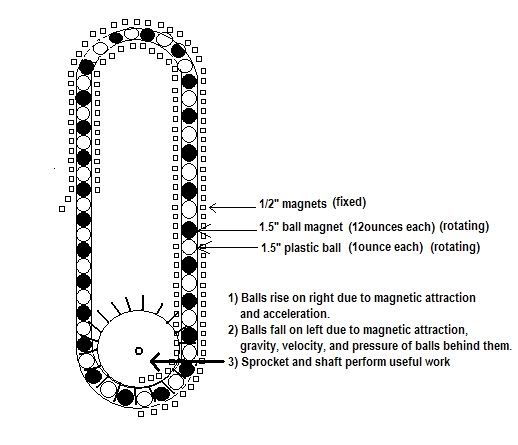This is a machine I built to test a theory I had. Itís based on a spiral being a long curved ramp, and some steel balls building up angular speed, and also momentum in the wheel, as they descend.
I reasoned that the energy built up by multiple balls combined with the wheel would be enough to lift one ball back to the start near the center.
It didnít work as I have it built.
I found that the tracks have to be very smooth and even, otherwise it creates parasitic oscillations in the balls as they roll towards the bottom. This robs a lot of energy from the system.
I think the tracks need to be a little steeper too. This would build up more inertia and centrifugal force, which would add needed energy.
I was thinking the same concept could be done with a coil of tubing and some water. Replace the balls with segments of water and then connect the end of the tube back to the beginning. It would be easy to roll into a spiral anyway.
The point here is that even though it didnít work, it wasnít a failure. It is just the first step in finding out how a setup like this can be improved. Itís this way with every new concept, and it rarely works the first time.
Iím going to try and find a better track material, and change the angle of the spiral, for the next iteration. Weíll see if that improves things.

Cheers,
Ted
I reasoned that the energy built up by multiple balls combined with the wheel would be enough to lift one ball back to the start near the center.
It didnít work as I have it built.
I found that the tracks have to be very smooth and even, otherwise it creates parasitic oscillations in the balls as they roll towards the bottom. This robs a lot of energy from the system.
I think the tracks need to be a little steeper too. This would build up more inertia and centrifugal force, which would add needed energy.
I was thinking the same concept could be done with a coil of tubing and some water. Replace the balls with segments of water and then connect the end of the tube back to the beginning. It would be easy to roll into a spiral anyway.
The point here is that even though it didnít work, it wasnít a failure. It is just the first step in finding out how a setup like this can be improved. Itís this way with every new concept, and it rarely works the first time.
Iím going to try and find a better track material, and change the angle of the spiral, for the next iteration. Weíll see if that improves things.

Cheers,
Ted



Comment